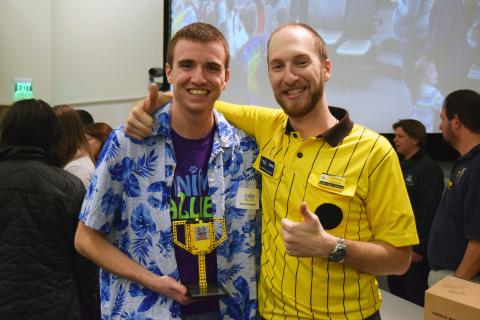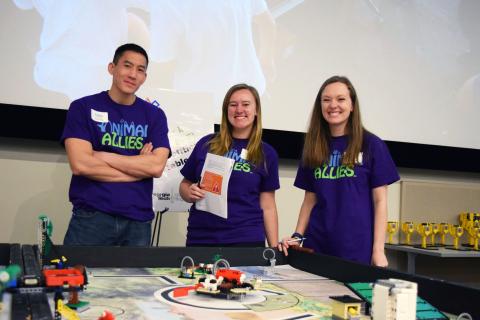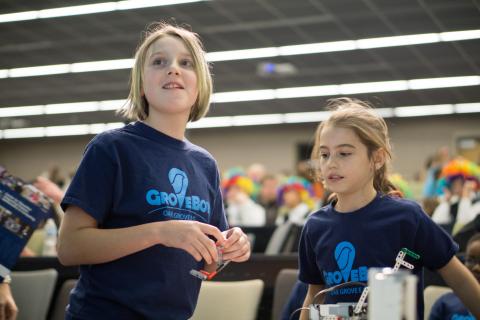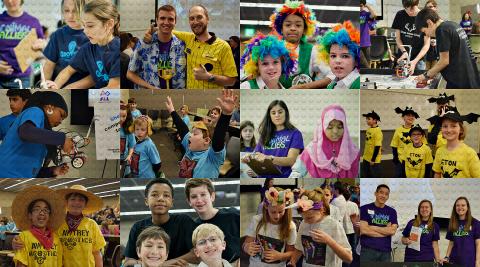Each year, Georgia Tech hosts the FIRST LEGO League State Championship Tournament and welcomes more than 200 budding engineers and scientists to campus.
On a Saturday in early winter the Georgia Tech Student Center turns into a playground for budding scientists and engineers. Divided into cleverly named teams and wearing matching tee shirts, about 200 school kids descend onto campus, representing the best and the brightest that Georgia has to offer.
Infused with a sense of fun and cooperation, the teams battle it out in the annual Georgia FIRST® LEGO League (FLL) State Championship Tournament. The atmosphere is electric. Excited, proud, and determined teams have their eyes on the ultimate prize—a coveted trophy made out of LEGOs and bragging rights for at least the next year.
All across the world, FIRST® LEGO League teams are forming to solve real world challenges that impact society such as animal welfare, food safety, natural disaster preparedness, and healthcare, to name a few. These groups of 9 – 14 year olds use science, technology, engineering, and math (STEM) skills to solve a specific problem. Challenges issued by FIRST® LEGO League each August consist of three parts: the Robot Game, the Project, and Core Values. Teams design and program an autonomous robot using LEGO Mindstorms technology, develop a solution to a problem and present it to judges, and adhere to core values that foster mutual gain and friendly competition where learning and teamwork are more important than winning.
Georgia Tech and the FIRST® LEGO League Connection
Georgia Tech has been involved in the FIRST® LEGO League program since 2002 through the Center for Education Integrating Science, Mathematics, and Computing (CEISMC), FLL’s operational partner in Georgia and Tennessee, the School of Electrical and Computer Engineering (ECE), and Women in Electrical and Computer Engineering (WECE). One of two state championship tournaments is hosted by Georgia Tech each year.
There are currently 672 teams in the state of Georgia, making Georgia FLL the largest single region in the country. Many of the teams come from the public school system where STEM clubs, engineering clubs, and afterschool programs engage diverse groups of students hungry for real world engineering challenges. Over the years, the program has been a great feeder for students choosing science and engineering majors in college. Statistics show that among FLL participants 88% are more interested in excelling in school and 87% have an increased interest in going to college.
ECE instructor Tom Collins has been involved with the Tournament almost since its inception. He is the primary recruiter for competition judges each year. The event needs upwards of 30 judges to evaluate teams. He’s seen the program grow over the years and steadily increase in popularity with girls and underrepresented minorities in particular. Overall, 35% of participants in Georgia are female and 37% are underrepresented minorities.
“FLL draws kids towards subjects they might not have thought about and sparks their interest. Not only does it appeal to the science and math loving kids, but it also brings in a variety of students inspired by the fact that it’s an inherently social and creative activity. STEM subjects are just the conduit to solve important problems and be a part of a community—to essentially make the world a better place,” Collins said.
The nuts and bolts of participation
Teams are generally coached by a teacher or parent and include between two and 10 students (most average around six). New teams can expect to pay approximately $900 for team registration, a robot kit of parts, and a Challenge Set (formerly known as the Field Setup Kit). Additional costs for event participation, travel, food, team shirts, and other optional items will vary. Veteran teams will pay less since the robot set can be used year after year.
Robots are judged based on design, uniqueness, and programming. Incorporated into these criteria is the team’s strategy for playing the game. Each game consists of 10 - 14 “missions” that could include activities such as retrieving an object on the field, pushing an object to a specific location, or dispensing a part. With only two and a half minutes to complete as many missions as possible, the team has to use critical thinking to decide which missions to tackle based on level of difficulty and the points that can be earned.
Successful teams progress from their Regional competition to a Super Regional and then to the State Championship. Winners from the Championship Tournament converge at the World Festival, which features teams from around the world.
Alumni become volunteers
The Championship Tournament at Georgia Tech needs over 80 volunteers on the day of the event. Roles such as judges, pit managers, technical advisors, referees, and many more are required to keep the event running smoothly. A large portion of the volunteer roles are filled by Georgia Tech students. In between building and resetting fields and coordinating course builders, volunteers act as supporters and entertainers to the kids who one day may fill their shoes.
“The energy and sense of excitement in the place is extreme, so showing off my dancing skills (or lack of them) to keep waiting teams entertained seemed like a fitting volunteer role,” said electrical engineering major Noah Daugherty.
Daugherty has volunteered for multiple FLL events over the past two years, but he has been involved with FLL since his freshman year of high school. Many volunteers and coaches are alumni of the program themselves and keep returning to their LEGO Robotics “family.”
Local teams seek statewide acclaim
Of the nearly 700 teams in Georgia, one such team is the Grovebots from Atlanta’s Oak Grove Elementary School. The team is currently made up of four fourth graders and three fifth graders broken into three different parts: project, programming, and building. The builders work closely with the programmers on the robot itself. The rest of the team works on a complex science project based on the theme for the year. This year’s theme of Animal Allies inspired the Grovebots to use infra-red cameras and software to identify “hotspots” of animal activity on the school grounds. The objective was to give guidance to exterminators on places to avoid in order to help save the bluebird population.
Being on a successful FLL team requires a lot of work both during and after school. Eirinn Lucas, who is a programmer for the Grovebots, had to undergo a competitive tryout process to join the team. Only half of the kids that tried out made it after answering questions about teamwork and leadership and presenting a skit.
The time commitment is no small matter. In the weeks leading up to the first regional competition, the Grovebots teammates were spending two to three hours of regular class time in addition to time after school each day in preparation. In their case, the hard work paid off: the Grovebots won Best Robot Game and Best Overall in both the Regional and Super Regional competitions. Once they got to the State Championship Tournament at Georgia Tech, they found themselves competing alongside the top teams in Georgia – many of which included 7th and 8th graders. They earned the 24th best Robot Performance Score out of more than 300 teams statewide which meant Eirinn and her teammates “got to swagger all over the school” because they were the first team in Oak Grove history to make it to the State Championship.
The team will continue improving on their robot and learning new skills as well as training younger students to take the place of those who depart. The important part of the experience has been the ongoing learning and teamwork that are hallmarks of FLL.
Ryan Lucas, Eirinn’s father, saw firsthand the benefits of his daughter’s participation. “I witnessed some points of frustration when the robot just wasn’t working the way they wanted. But the rewarding part was seeing Eirinn and her cohorts push through and find the solution. If invention is 1% inspiration and 99% perspiration, it’s heartening to see her learn to deal with the perspiration,” Lucas said.
And the hard work today could lead to a high-paying and fulfilling career in the future. Eirinn, who wants to come to Georgia Tech and study engineering one day, now has great experience and a launch pad into the Institute—where effort, innovation, and fun go hand in hand.
Additional Images




